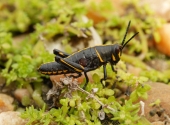Jabba the Hutt is a fictional character appearing in Star Wars. He is depicted as a large, slug-like alien. His appearance has been described as a cross between a toad and the Cheshire Cat.
So we had these fat, pink, morbid obese 3" grasshoppers that cannot fly or hop very far. I have been looking for what kind of grasshopper they are for months. Found out today!
Romalea microptera also known as Devil’s Horses.
A popular ... childhood past time before computer games was to harness lubbers to a matchbox and pretend they were horses pulling wagons.
One might expect that lubbers’ abundance makes them an important food source for many species of animals. Some are undoubtedly eaten by predators. But lubbers’ preferred food, members of the lily family Liliaceae (such as our swamp lily, Crinum americanum, and spider lily, Hymenocallis caroliana) and the Smilacaceae (the cat claws of the genus Smilax), contains allelochemicals that make lubbers distasteful to many other animals.
Lubber grasshoppers are not capable of flight. They have two pairs of wings covered by rather short, black wing covers. The anterior wings are yellowish with black dots, and the rear wings, as mentioned above, are red or hot pink and function during communication with other lubbers or to potential predators.
They do not hop long distances like some grasshoppers. They simply amble along feeding and breeding. It is not uncommon to see thousands of lubbers moving across highways where they are slaughtered by traffic. Due to their large size, dark bodies, and slow gait, interstate highway commuters have even mistaken them for tarantulas.
Their value in the ecosystem aside, they have proven to be wonderful kid critters. They are sluggish and do not bite, their size and color cannot help but attract attention, and they are easy to keep in a jar. If you have budding naturalists in your family, take them out to see Devil’s Horses. [They will have] a wonderful day recently watching lubbers by the hundreds and hundreds. What an opportunity to help young minds grasp a higher understanding and appreciation of nature!
Lubbers are paurometabolous (a great cocktail party word) insects, meaning that their immature nymph stages each resembles the adult form. There are five nymphal stages, each called an instar, and each lasts about 15 days before it molts its external skeleton, thus moving to the next instar. They grow to full three-inch long imago (adult) size by midsummer, breed during the next few months, lay one to three clutches of about 50 eggs in two-inch deep holes in the soil, and die before winter.
If you have never experienced the explosion of lubber grasshopper populations, go into the field and observe. It is a real natural treat.
Southeastern Lubber Grasshoppers










